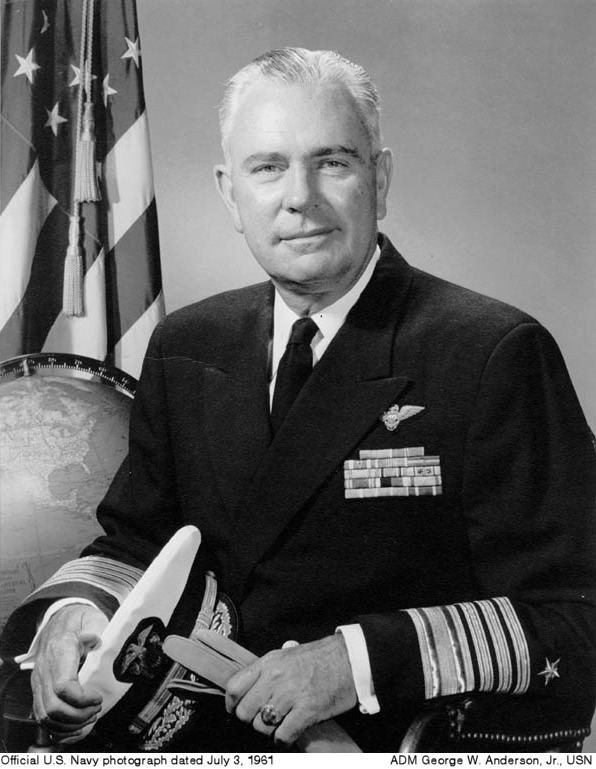Years of service 1927–1963 Role Jr. | Name George Anderson, Rank Admiral | |
 | ||
Birth name George Whelan Anderson, Jr. Born December 15, 1906Brooklyn, New York, U.S. ( 1906-12-15 ) Allegiance United States of America Commands held Chief of Naval OperationsUSS MindoroUSS Franklin D. Roosevelt Died March 20, 1992, McLean, Dranesville, Virginia, United States Place of burial Arlington National Cemetery, Arlington, Virginia, United States Similar People Nikita Khrushchev, John F Kennedy, Fidel Castro, Cemal Gursel, Arthur W Radford | ||
George Whelan Anderson Jr. (December 15, 1906 – March 20, 1992) was an Admiral in the United States Navy and a diplomat. He served as the Chief of Naval Operations (CNO) between 1961 and 1963, and was in charge of the U.S. blockade of Cuba during the 1962 Cuban Missile Crisis.
Contents
Early life and career
Born in Brooklyn, New York, Anderson entered the United States Naval Academy in 1923 and graduated with the class of 1927. After graduation he became a Naval Aviator and served on cruisers and aircraft carriers, including the USS Cincinnati.
In World War II he served as the navigator on the fourth USS Yorktown. After the war he served as the Commanding Officer of the escort carrier USS Mindoro and of the USS Franklin D. Roosevelt. He also served tours as an assistant to General Dwight D. Eisenhower at the North Atlantic Treaty Organization, special assistant to the Chairman of the Joint Chiefs of Staff Radford and as Chief of Staff to the Commander in Chief Pacific.
Flag assignments
As a flag officer he commanded Task Force 77 between Taiwan and mainland China, Carrier Div 6 in the Mediterranean during the 1958 Lebanon landing and as a vice admiral, commanded the United States Sixth Fleet.
As Chief of Naval Operations in charge of the United States' quarantine of Cuba during the Cuban Missile Crisis in 1962, Admiral Anderson distinguished himself in the Navy's conduct of those operations; Time magazine featured him on the cover and called him "an aggressive blue-water sailor of unfaltering competence and uncommon flair." He had, however, a contentious relationship with Secretary of Defense Robert S. McNamara. At one point during the crisis, Anderson ordered McNamara out of the Pentagon's Flag Plot when the Secretary inquired as to the Navy's intended procedures for stopping Soviet submarines; McNamara viewed Anderson's actions as mutinous and forced the Chief of Naval Operations to retire in 1963. Many senior naval officers had believed Anderson's next appointment would have been to Chairman of the Joint Chiefs of Staff.
Other public service and post-Navy career
Anderson took early retirement, largely due to ongoing conflict with Secretary of Defense Robert McNamara.
President John F. Kennedy subsequently appointed Admiral Anderson Ambassador to Portugal, where he served for three years and encouraged plans for the peaceful transition of Portugal's African colonies to independence. He later returned to Government service from 1973 to 1977 as member and later chairman of the President's Foreign Intelligence Advisory Board.
After his retirement from the Navy, he was chairman of Lamar Corporation, an outdoor advertising company, and was a director on the boards of Value Line, National Airlines and Crown Seal and Cork.
Family and last years
His first wife, Muriel Buttling 11-9-1911-*10-20-1947,. His two sons, George W. Anderson III, 4-21-1935-1-11-1986,died of brain cancer and Thomas Patrick Anderson 4-3-1942-6-24-1978 (who flew more than 200 combat missions in Vietnam) . Admiral Anderson died March 20, 1992 of congestive heart failure at the age of 85, in McLean, Virginia. He was survived by his second wife of 44 years, the former Mary Lee Sample; a daughter, a stepdaughter, 12 grandchildren and 4 great-grandchildren. He was buried on March 23, 1992 in Section 1 of Arlington National Cemetery.
George Jr, Muriel Buttling, sons George III & Thomas Patrick are all buried at Arlington.
